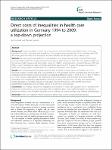Direct costs of inequalities in health care utilization in Germany 1994 to 2009: a top-down projection
Kroll, Lars Eric
Lampert, Thomas
Background: Social inequalities in health are a characteristic of almost all European Welfare States. It has been estimated, that this is associated with annual costs that amount to approximately 9% of total member state GDP. We investigated the influence of inequalities in German health care utilization on direct medical costs. Methods: We used longitudinal data from a representative panel study (German Socio-Economic Panel Study) covering 1994 to 2010. The sample consisted of respondents aged 18 years or older. We used additional data from the German Health Interview and Examination Survey for Children and Adolescents, conducted between 2003 and 2006, to report utilization for male and female participants aged from 0 to 17 years. We analyzed inequalities in health care using negative binomial regression models and top-down cost estimates. Results: Men in the lowest income group (less than 60% of median income) had a 1.3-fold (95% CI: 1.2-1.4) increased number of doctor visits and a 2.2-fold (95% CI: 1.9-2.6) increased number of hospital days per year, when compared with the highest income group; the corresponding differences were 1.1 (95% CI: 1.0-1.1) and 1.3 (95% CI: 1.2-1.5) for women. Depending on the underlying scenario used, direct costs for health care due to health inequalities were increased by approximately 2 billion to 25 billion euros per year. The best case scenario (the whole population is as healthy and uses an equivalent amount of resources as the well-off) would have hypothetically reduced the costs of health care by 16 to 25 billion euros per year. Conclusions: Our findings indicate that inequalities and inequities in health care utilization exist in Germany, with respect to income position, and are associated with considerable direct costs. Additional research is needed to analyze the indirect costs of health inequalities and to replicate the current findings using different methodologies.
No license information

